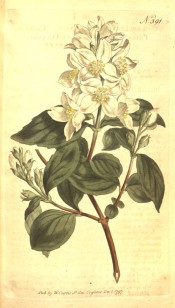Philadelphus coronarius L.
Fully hardy, broadly upright deciduous shrub with ovate, shallowly-toothed leaves, to 10cm long, and short terminal racemes of up to 9 cup-shaped, very fragrant, single creamy white flowers, to 2.5cm across, in summer. To 3m. [RHSE, Hilliers’].
Horticultural & Botanical History
‘The Philadelphus coronarius is one of the most common shrubs of our gardens, and known to most persons by the name of Mock-orange, the blossoms in point of scent being supposed to have some affinity with those of the orange. […] This shrub is hardy, and readily propagated by suckers; it usually flowers in May, but it is only in seasons unusually mild and favourable, that its blossoms and foliage are seen in perfection, as they are very apt to be disfigured by the cold winds which, more or less, prevail at that time; it is only when gently forced that its beauty is fully displayed, and for that purpose it is a shrub often used. It was cultivated by Gerard in 1597. Clusius observes, that he never saw it in a wild state, nor had he been able to determine whether it was known to the ancients; Linnaeus seems to have had his doubts as to its original place of growth, by putting “Habitat Veronae” with a quere; Miller says, where it naturally grows is uncertain; Mr. Aiton describes it as a native of the South of Europe. A dwarf variety of it is mentioned by authors, which has little to recommend it; and another with variegated foliage, which is apt to become wholly green. The leaves, as authors have observed, taste like cucumber.’ [BM t.391/1797].
History at Camden Park
Listed in all published catalogues [T.746/1843].
Notes
Published Feb 14, 2010 - 12:12 PM | Last updated Feb 14, 2010 - 12:28 PM
| Family | Hydrangeaceae |
|---|---|
| Category | |
| Region of origin | Southern Europe, Caucasus |
| Synonyms | |
| Common Name | Mock orange |
| Name in the Camden Park Record |
Philadelphus coronarius - Common Syringa |
| Confidence level | high |


